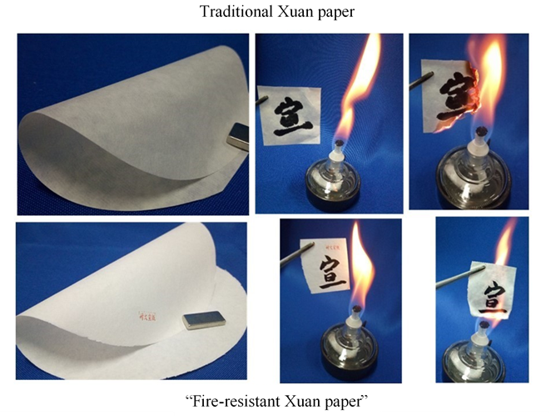Xuan paper is an excellent example of the traditional handmade paper. Its home locates in Jing County, Anhui Province in eastern China. Xuan paper features excellent properties of durability, ink wetting, and resistance to insects and mildew. It is the best material carrier for the calligraphy and painting arts, many of which have been well preserved for hundreds of years. The excellent durability of Xuan paper is attributed to its unique raw materials and handmade manufacturing process under mild conditions. The bark of pteroceltis tatarinowii, a common species of elm in the area, is used as the main raw material to produce Xuan paper. Limestone particles are deposited on the surface of pteroceltis bark fibers, which can neutralize acids produced by the hydrolysis of plant fibers and from the environment.
However, since the raw materials are only produced in Jing County, Anhui Province in China, the Xuan paper suffers from a severe shortage. Moreover, the traditional hand making process for Xuan paper strictly follows over 100 steps, thus it takes nearly two years. Furthermore, the traditional Xuan paper is flammable, which has accidently caused a lot of precious calligraphy and painting works burnt to ashes in the fire.
Recently, a research team, led by Professor Ying-Jie Zhu from Shanghai Institute of Ceramics, Chinese Academy of Sciences, has successfully developed a new kind of “fire-resistant Xuan paper” based on ultralong hydroxyapatite nanowires. In their work, the unique integral structure of the “fire-resistant Xuan paper” with excellent mechanical properties and high flexibility was innovatively designed, which is similar to the reinforced concrete structure in tall buildings. Ultralong hydroxyapatite nanowires are used as the main building material, which is similar to the concrete in the reinforced concrete structure. Silica glass fibers with micrometer-sized diameters are used as the reinforcing framework material, which are similar to supporting steel bars in the reinforced concrete structure. In addition, a new kind of inorganic adhesive composed of amorphous nanoparticles is designed, prepared and used as the binder in the “fire-resistant Xuan paper”.
The as-prepared “fire-resistant Xuan paper” well keeps its properties even after the simulated aging for up to 3000 years. The original whiteness of the “fire-resistant Xuan paper” is 92%, and its whiteness has a slight decrease to 91.6%, with the whiteness retention as high as 99.6% after the simulated aging for 2000 years. Even after the simulated aging for 3000 years, its whiteness only decreases to 86.7% with 94.2% of the whiteness retention. It is much higher than that of the traditional Xuan paper. The whiteness of the traditional unprocessed Xuan paper decreases from initial 70.5% to 47.3% with 67.1% of the whiteness retention after the simulated aging for 2000 years. Its whiteness decreases to 42.2% with 59.9% of the whiteness retention after the simulated aging for 3000 years. (Figure 2)
The“fire-resistant Xuan paper” exhibits superior mechanical properties during the simulated aging process. The retention percentage of tensile strength of the “fire-resistant Xuan paper” is as high as 95.2% (aging for 2000 years), and 81.3% (aging for 3000 years). In contrast, the average retention percentage of tensile strength of the unprocessed Xuan paper is only 54.9% (aging for 2000 years), and 40.4% (aging for 3000 years). Furthermore, the “fire-resistant Xuan paper” has an excellent ink wetting performance, which is mainly attributed to the nanoscale porous structure and hydroxyl groups of utralong hydroxyapatite nanowires.
Besides, the prevention of mould growth on the paper is a great challenge, because the mould can cause the deterioration of the Xuan paper. The experiments show that different kinds of mould spores do not breed and spread on the “fire-resistant Xuan paper”, and it is able to maintain a clean surface without the growth of any mould, indicating the excellent anti-mildew performance of the “fire-resistant Xuan paper” even exposure to the external nutrients. On the contrary, the growth and spread of mould are obviously observed on the traditional Xuan paper in the presence of external nutrients, indicating that its anti-mildew performance is not satisfactory.
The most important property is that the “fire-resistant Xuan paper” is fire resistant and highly thermal stable. Thus it can prevent the precious calligraphy and painting works as well as books, documents, and archives from the damage by fire. In addition, the production process of the “fire-resistant Xuan paper” is simple, highly efficient, and it only needs 3~4 days to produce.
The paper has been published in ACS Sustainable Chemistry & Engineering (2018, 6, 17239–17251). The related studies were supported by the National Natural Science Foundation of China.

The traditional Xuan paper is flammable. The as-prepared “fire-resistant Xuan paper” features the properties of excellent fire resistance, high thermal stability, and high whiteness.

The ink wetting and writing performance of the as-prepared “fire-resistant Xuan paper” in comparison with the traditional Xuan paper.

Evaluation of the whiteness stability of the as-prepared “fire-resistant Xuan paper” in comparison with the traditional Xuan paper by the simulated aging method for up to 3000 years.
Reference: https://pubs.acs.org/doi/pdf/10.1021/acssuschemeng.8b04630
Contact:
Prof. Ying-Jie Zhu
Shanghai Institute of Ceramics
y.j.zhu@mail.sic.ac.cn



